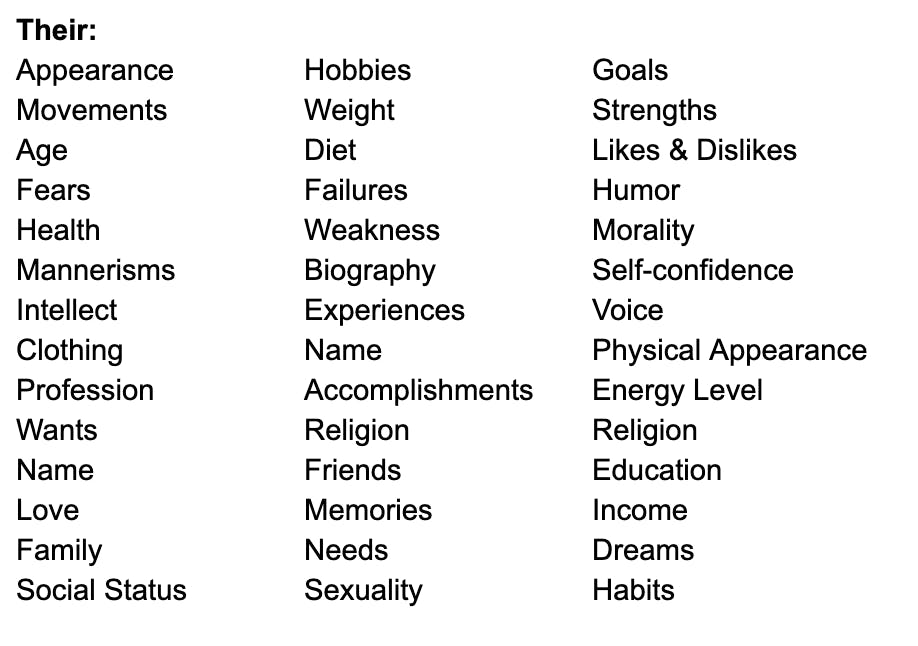
When you're thinking of who your ideal client is, dig deep and ask yourself these three important questions to help get the ball rolling.
Very recently I attended a branding lecture. A person who had written books about branding was paid a lot of money to stand up and tell us the secrets of branding and, you know, sell the books they had written as well.
I noticed a few things; the speaker was dressed in an obviously calculated manner to show they were worldly and because of that we must listen to them. They weren’t a very compelling speaker as the listeners often drifted off into conversations between themselves or spent time rummaging through the remains of their box lunches and no one seemed eager to answer the questions she was asking. But mostly I noticed the speaker said it is vital to be specific when thinking about the ideal customer, that one target person you’re thinking about when creating a brand and yet, the speaker was chronically unspecific.
I agree with this speaker, being specific, not just when thinking about branding, is vital to communication and to get at the heart of most things. Specificity or, as a great teacher of mine used to say: speci-fucking-ficity is the key.
What's Important
Now, I am going to ask you to imagine your ideal customer, that person we’re always told to think about when we’re in a branding session. Get them in your mind, put them in a chair in an empty room and look at them. What is interesting about them? What would cause us to pursue them? What would make us want to focus on them? Let’s look at a partial list of their attributes:

Now, from this partial list, we can see that targeting that client needs to be very specific and there are a lot of attributes that we need to consider to start with. We need to think of all these things to get to that specific person, right?
Wrong.
The one word on the list that will get you to the core of that person you’re targeting, the one word that is going to get you to the innermost truth of the person you’re imagining is:
Wants
You need to understand someone, target them, get specific with them, what you need to know is: What Do They Want?
Want Versus Need

What someone wants is powerful because it’s part of a troika that will allow you to quickly delve deep and see who a person is. It’s going to take some serious delving but once you do, you’ll see how incredible the power of want is.
Wants are also great because they carry the magic of specificity which is preached from corporate pulpits and at high priced branding lectures around the globe.
Something else I noticed about this branding speaker was that they interchanged wants and needs constantly. You can do that if you so desire yet know that if you do, you’re sacrificing specificity and clarity.
There is a chart, a pyramid that gets touted out at these things and there are vague, rather apocryphal references to Mazlow. Tiers of attributes that bring you to the top and suddenly you’re self-actualized and the perfect brand is presented to you in cupcake form and you eat it and become Nike. Fine, but this chart, this tried and true pyramid can be rather unspecific.
On the bottom level are the basics, food, water, vehicle, job, the word spatula and such. And here’s where we start. In fact, we need not go any further. If we’re starting to be specific right now.
We all need food. But what does your perfect client want?
There’s a diner in Oswego, New York, called Warrendorf’s. For personal reasons, I hold that place special in my memory. One of the things that I recall viscerally is the broccoli, bacon and cheddar omelet. It was huge, full of yumminess and they had a way of cooking it that burned an edge of cheddar around the omelet. Now, we all need food. We all need breakfast, it’s the most important meal of the day kids, but, if asked, I would say I want that broccoli, bacon, and cheddar omelet from Warrendorf’s.
A want is much more specific than a need. Do not confuse the two. Do not casually mix the two because the want is going to give you the clearest sense of who that person is. I want that huge, unhealthy, artery-clogging omelet. Dave wants the spirulina shake with a shot of wheatgrass from Bixby’s Health Emporium. We are different. We are specific.
How We Learn

Here’s something interesting and helpful; we learn in threes. It’s true. We learn deeply, we hold onto ideas, information and the basics of life by learning in threes.
The first step to learning is discovering. The second step to learning is testing and the third step to learning is pattern-setting. Three is a very magic number. And I don’t mean that in a get the candles, hold hands, kill a brindle calf in the moonlight kind of way. I mean that threes are all around us and they are part of us. Ask any comedian and they’ll tell you, comedy comes in threes. A joke follows an AAB pattern. Two sets and a punchline. This is always much funnier than an AB pattern or an AAAB pattern. Threes are how we learn so threes are how we connect.
Just Three Questions

If you attend one of this person’s branding lectures they are going to show you a slide that has several questions on it. These questions, you will be told, are how to get specific about the ideal client. Some of the questions are: What do they LOOK like? What are they AFRAID of? What is their DAY like? And such. Good questions however, these are questions that you can ask down the line. They aren’t the kind of questions that are going to get you to the heart of who the ideal customer is and thus make them much more clear to target and thus easier to build your brand toward.
To start with on this journey to discovering the depths of this person, you need to ask only three questions:
What do you want?
Why do you want it?
How are you going to get it?
These three questions work well because, first off, it’s three and that’s how we learn. Secondly, they are specific. And third, you can use them to dig deep.
What Do You Want?
This is important because we all live in a system of wants and those wants are specific, there’s that word again, to us as individuals.
This is also a good question because it is more specific than needs. And, if you think that the specific type of food that a person wants isn’t important, then you haven’t looked at the top running brands in the Statista chart of top-selling, most powerful brands.
Campbell’s soup is on that list. That’s MMMM-MMMM-Good. It’s also a direct connection to memory. Memory is emotion and emotion drives us to want.
If we go back to my want of that omelete at Warrendorf’s and keep digging you’re going to discover that it wasn’t really that omelet that I craved. It was a good omelet, really good, and for the two months I lived in Oswego, I ate one almost every Monday morning. So I wanted that omelet. That’s part one of the learning, the discovery, the next part takes us deeper.
Why Do You Want It?
This is tricky because in order to get really deep you need to ask why a lot. I mean, a lot, a lot. You need to keep asking why because the first three to seven answers are going to only be the first three to seven layers of skin. When asking why, you need to keep digging, keep asking til you hit the bone. You’ll know because when you hit the bone, it will be personal, it will be truthful and it will usually surprise the person you’re asking. It will also be annoying like a child that keeps asking but why? The more you do this, the more you’ll formulate other ways of asking why but, to start, keep asking why?
Why do you want it?
As I said, the omelet I want isn’t what I really want. So, I ask why a million times and I dig down deep, I get to the truth. Here’s what I get if I ask why a million times:
I was working at a Renaissance faire as part of an improv troupe and we were good. I was young, 18 and I discovered that I was funny. I had been beaten up all my life, been called names, felt like an outcast, had few friends, thought I was stupid, ugly all of that. Then, I started working with this troupe of very smart, very funny, very quick-witted people and they liked me. They thought I was funny and quick and I learned to hone my skills. We performed Saturdays and Sundays, long days of making people laugh, doing stage shows but also street work and then, Monday morning, we would gather, late in the morning at Warrendorf’s, have breakfast and break down the work. What was funny, what didn’t land, what we need to develop. We were speaking the language of comedy and I was being listened to. I was occupying a few tables with my people. Other people who worked at the faire would come in, they would say hello and they would leave us alone because we were working on getting better. We were respected. And I was a part of it.
The omelet is just the conduit to the memory. When you ask why do you want it, you get deeper to the core and you understand the truth. I want that omelet because it reminds me of a time when I was fast, funny, respected and part of a company.
What do you want? Broccoli, bacon, and cheddar omelet form Warrnedorf’s in Oswego, New York.
Why do you want it? Because it reminds me of when I was discovering my passion.
Ask again.
What do you want? Broccoli, bacon, and cheddar omelet form Warrnedorf’s in Oswego, New York.
Why do you want it? Because I want to be passionate again.
That’s some hard truth. But that’s also some deep truth. Now, you know something about what’s really going on inside of me. Does that help you target me if I’m your ideal customer? Yes, yes it does.
Understand that for the purposes of this piece I cut to the chase rather quickly but, when you’re asking the why do you want it question, it’s going to take a lot more why to get to that bone. Be patient, be persistent and you will know when you get there because you will hear it.
This is part two of the learning three. Part one: what do you want? That’s discovery. Part two: why do you want it? That’s testing. And now …
How Are You Going to Get it?
This is the last question and one that gives you, the one who is creating a brand, serving a customer, building a website, a chance to be the one who is really answering it.
How are you going to get it is going to shed some more light on who the ideal customer is and it’s going to give you a chance to specifically be the one who makes them achieve what they so dearly want.
So, back to the example:
What do you want? Broccoli, bacon, and cheddar omelet form Warrnedorf’s in Oswego, New York.
Why do you want it? (the deep answer) Because I want to be passionate again.
How are you going to get it? Well, I could take a class, join an improv troupe, do things that reignite my passion …
And there it is:
I want someone or something that’s going to reignite my passion.
Now that person, consciously or unconsciously, is going to be attracted to brands and experiences, products and services that reignite their passion.
However, what ignites their passion and what their passion manifests itself as will be specific and unique to each person. So, you can still look at the client in a group of people who want their passion lit up as well as looking at them for individual passions. Your possibilities have become numerous. Your target audience is both specific and varied.
Best of all you know it’s going to land because now you’ve filled in the third part of the learning triad, you’re building patterns.
Occam’s razor.
I’ve always seen Occam’s razor as getting down to the simple, the core, the specific and it applies here. We can look at the list of attributes, spend hours trying to fulfill them and drive ourselves crazy or we can start simple, which really is the best way.
What do you want?
Why do you want it?
How are you going to get it?
It’s clear, it’s specific and it allows you to keep digging. And, ultimately, when you ask and ask and dig and dig, the answer to the final question is; Well, I’m going to come to you. I’m going to buy your product. I’m going to trust your brand.
It’s about emotional connection, what that means to your personal client and how that informs, shapes and drives their specific want. We learn in threes, we laugh in threes, we should brand in threes.

